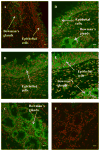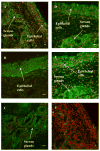Gene expression and immunochemical localization of major cytochrome P450 drug-metabolizing enzymes in bovine nasal olfactory and respiratory mucosa
- PMID: 26572092
- PMCID: PMC4970319
- DOI: 10.3109/08958378.2015.1066903
Gene expression and immunochemical localization of major cytochrome P450 drug-metabolizing enzymes in bovine nasal olfactory and respiratory mucosa
Abstract
Despite tremendous advancement in the characterization of nasal enzyme expression, knowledge of the role of the nasal mucosa in the metabolism of xenobiotics is still inadequate, primarily due to the limited availability of in vitro models for nasal metabolism screening studies. An extensive knowledge of the oxidative and conjugative metabolizing capacity of the cattle (Bos taurus) olfactory and respiratory mucosa can aid in efficient use of these tissues for pre-clinical investigations of the biotransformation and toxicity of therapeutic agents following nasal administration or inhalation. Cows are also exposed to a variety of airborne pollutants and pesticides during their lifetime, the metabolism of which can have profound toxicological and ecological consequences. The aim of the present study was to characterize cytochrome P450 (CYP) enzyme expression in the bovine nasal mucosa. Amplification of the specific genes through RT-PCR confirmed expression of several CYP enzymes in bovine hepatic and nasal tissues. The results demonstrate that bovine nasal olfactory and respiratory mucosal and liver tissues express similar populations, families, and distributions of CYP enzymes, as has been previously reported with other species, including humans. Bovine ex vivo tissues can serve as a readily available reference tissue to elucidate preclinical toxico-kinetic effects resulting from exposure to substances in the environment or following drug administration.
Keywords: Cytochrome P450; Real Time-PCR; gene expression; immunohistochemistry; metabolism; nasal mucosa.
Conflict of interest statement
The authors report no conflict of interest in the work described in this report.
Figures








Similar articles
-
Regulation of cytochrome P450 gene expression in the olfactory mucosa.Chem Biol Interact. 2004 Apr 15;147(3):247-58. doi: 10.1016/j.cbi.2004.02.003. Chem Biol Interact. 2004. PMID: 15135081
-
Nasal cytochrome P450 2A: identification, regional localization, and metabolic activity toward hexamethylphosphoramide, a known nasal carcinogen.Toxicol Appl Pharmacol. 1997 Jan;142(1):22-30. doi: 10.1006/taap.1996.7975. Toxicol Appl Pharmacol. 1997. PMID: 9007030
-
Cell-specific activation of aflatoxin B1 correlates with presence of some cytochrome P450 enzymes in olfactory and respiratory tissues in horse.Res Vet Sci. 2003 Jun;74(3):227-33. doi: 10.1016/s0034-5288(02)00191-1. Res Vet Sci. 2003. PMID: 12726741
-
Xenobiotic metabolizing cytochrome P450 in pig, a promising animal model.Curr Drug Metab. 2011 Jul;12(6):507-25. doi: 10.2174/138920011795713698. Curr Drug Metab. 2011. PMID: 21476973 Review.
-
Human extrahepatic cytochromes P450: function in xenobiotic metabolism and tissue-selective chemical toxicity in the respiratory and gastrointestinal tracts.Annu Rev Pharmacol Toxicol. 2003;43:149-73. doi: 10.1146/annurev.pharmtox.43.100901.140251. Epub 2002 Jan 10. Annu Rev Pharmacol Toxicol. 2003. PMID: 12171978 Review.
Cited by
-
Endocytic Uptake of Solid Lipid Nanoparticles by the Nasal Mucosa.Pharmaceutics. 2021 May 20;13(5):761. doi: 10.3390/pharmaceutics13050761. Pharmaceutics. 2021. PMID: 34065558 Free PMC article.
References
-
- Abramoff MD, Magalhaes PJ, Ram SJ. Image Processing with ImageJ. Biophotonics Int. 2004;11:36–42.
-
- Brittebo EB. Metabolism-dependent activation and toxicity of chemicals in nasal glands. Mutat Res. 1997;380:61–75. - PubMed
-
- Chen Y. Immunoblot analysis and immunohistochemical characterization of CYP2A expression in human olfactory mucosa. Biochem Pharmacol. 2003;66:1245–1251. - PubMed
-
- Chen Y, Getchell M, Ding X, Getchell T. Immunolocalization of two cytochrome P450 isozymes in rat nasal chemosensory tissue. Neuroreport. 1992;3:749–752. - PubMed
-
- Dahl AR, Hadley WM. Nasal cavity enzymes involved in xenobiotic metabolism: effects on the toxicity of inhalants. Crit Rev Toxicol. 1991;21:345–372. - PubMed
Publication types
MeSH terms
Substances
Grants and funding
LinkOut - more resources
Full Text Sources
Other Literature Sources
